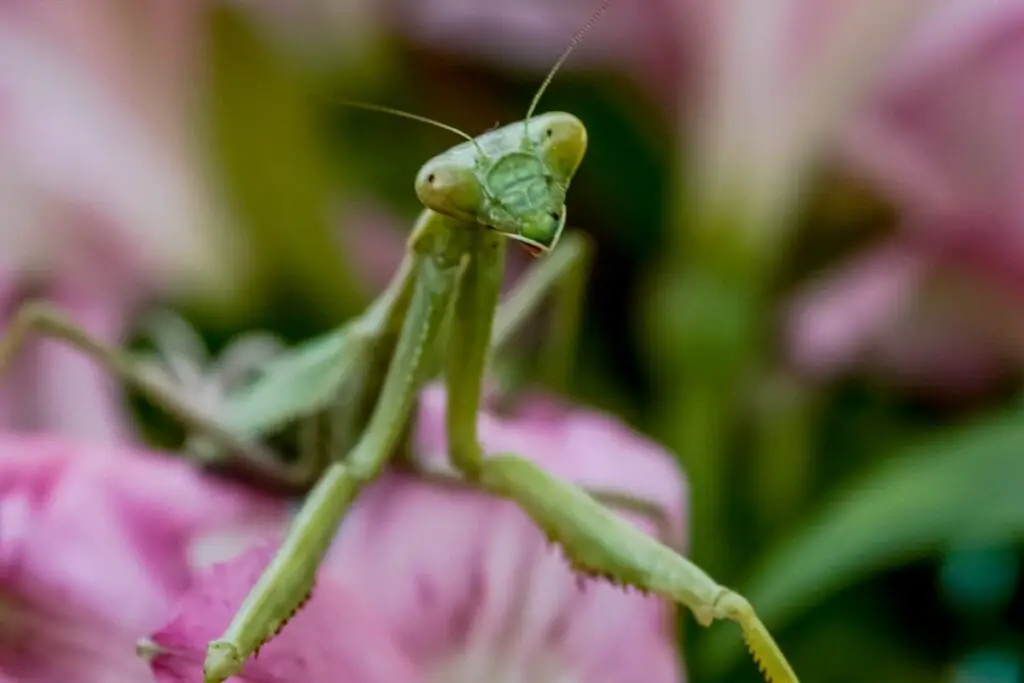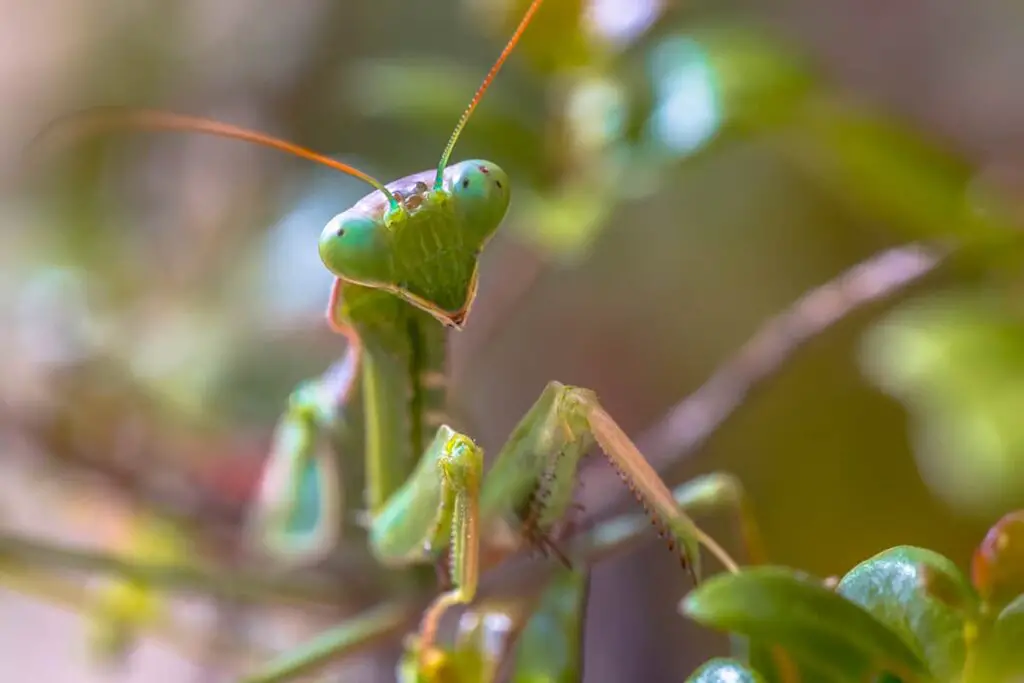Caring for a praying mantis requires understanding their dietary needs to keep them healthy and thriving. If you’re a beginner at mantis keeping, knowing what to feed your praying mantis is crucial. These fascinating insects are predominantly carnivorous and, in nature, they consume a variety of live prey. In captivity, your pet mantis will rely on you to provide suitable live insects for them to hunt. Offering a range of feeder insects not only maintains their health but also supports their natural hunting behavior.
Selecting the right size and type of prey is essential. Typically, the insects you feed to your mantis should not be larger than one-third of the mantis’s size. This ensures that your mantis can safely handle and consume the insects. For young mantids, this means starting with smaller prey such as fruit flies or pinhead crickets and gradually moving to larger insects as they grow.
Setting up a proper feeding schedule is part of the fun of mantis care. Most mantids do well when fed every couple of days, but this can vary based on the species and the age of your mantis. Pay attention to their feeding habits and adjust accordingly. Remember, watching your praying mantis hunt is not just a necessary part of their care—it’s one of the joys of keeping such a unique pet.
Understanding Mantis Species
When delving into mantis care, you’ll first want to recognize the different species available to enthusiasts and understand their unique environmental preferences.
Recognizing Common Species
- Chinese Praying Mantis (Tenodera sinensis): Large and easy to find in the pet trade. Ideal for beginners.
- African Praying Mantis (Sphodromantis lineola): Known for its distinctive color and larger size among mantis species, suitable for newcomers.
- European Praying Mantis (Mantis religiosa): Common across Europe and adaptable to various environments, making it a good choice for starters.
- Giant Asian Praying Mantis (Hierodula membranacea): Impresses with its size and vibrant colors, though it requires a bit more space than smaller species.
For a deeper insight on beginner-friendly species, read about the best praying mantis species for absolute beginners.
Environment Preferences
Each mantis species thrives in certain conditions, and understanding this is crucial for their care:
- Temperature: Most mantis species prosper in temperatures ranging from 70°F to 85°F (21°C to 29°C).
- Humidity: It’s generally recommended to maintain a humidity level of 60% to 80% for optimal mantis health.
- Habitat: A spacious enclosure with vertical space for climbing and foliage for hiding, reflective of their natural habitat, is ideal.
For example, the African Mantis prefers a bit warmer environment, while the Chinese Mantis can be more flexible with temperature ranges within your home. Always tailor your mantis’s environment to mimic its natural habitat for the best care results.
Setting Up the Habitat
Creating a comfortable habitat for your praying mantis is essential for its health and well-being. Proper size, temperature, humidity, and decorations all contribute to a habitat where your mantis can thrive.
Choosing the Right Enclosure
For your praying mantis, you need an enclosure that is at least three times higher than the mantis’ length and twice as wide to allow for natural behaviors and growth. A suitable container could be a plastic or wooden vivarium with a secure lid. Ensure there are ample ventilation holes to provide a good air supply without allowing escape.
Temperature and Humidity Controls
Maintaining a consistent temperature between 70-75°F is crucial for the mantis’s survival. You can use a heating pad placed below or at the side of the enclosure to achieve this. Regular misting should keep the humidity at an appropriate level, as praying mantises require a humid environment to stay hydrated and healthy.
Plants and Decoration
Incorporating live plants such as ivy or fake foliage offers your mantis places to climb and camouflage. It also helps maintain the necessary humidity inside the habitat. Ensure any decorations are stable and do not pose a risk of falling and injuring your mantis.
Mantis Diet Basics
Understanding the basics of what your praying mantis eats and the frequency of feeding is pivotal for their health and longevity. Praying mantises are carnivorous and their diet should consist of live insects.
Choosing Prey for Your Mantis
Your praying mantis is a capable predator that prefers a diet of live insects. Small nymphs can be fed on fruit flies and other small insects. As they grow, you can introduce larger prey such as flies, crickets, moths, and small caterpillars. Adult mantises can handle even greater variety such as grasshoppers, beetles, and spiders. Variety is not just preferred – it’s beneficial, as it ensures a balanced intake of nutrients.
- For Small Nymphs:
- Fruit flies
- Small caterpillars
- For Juveniles:
- Houseflies
- Medium caterpillars
- For Adults:
- Cricket
- Grasshoppers
Feeding Frequency and Amount
Feed your mantis depending on its life stage and appetite. Young nymphs require daily feeding, while adults can be fed every 2-3 days. Monitor your mantis to ensure they’re neither underfed (which can lead to slow growth) nor overfed (which can cause mobility issues).
- Nymphs (Young mantises):
- Frequency: Daily
- Amount: 2-4 small insects
- Adults:
- Frequency: Every 2-3 days
- Amount: 1-2 large insects or an equivalent amount of smaller prey
Always remove uneaten prey after a few hours to prevent stress and potential harm to your mantis.
Health and Maintenance
When caring for your praying mantis, understanding how to spot health issues and ensuring the right care during the molting process are vital for maintaining your pet’s well-being.
Detecting Signs of Illness
Refusal to Eat: If your mantis turns down food consistently, it might indicate stress or an upcoming molt, but can also be a sign of illness.
Lethargy: A healthy mantis is alert. If yours seems sluggish for an extended period, this could be a concern.
Discoloration or Spots: Changes in body color or unusual spots can sometimes be symptoms of disease.
Molting Process and Care
Recognizing Molting Signs: Before a molt, mantises will often stop eating and become more inactive. You’ll notice they hang upside down to shed their old exoskeleton.
Post-Molt Care: Ensure the habitat has adequate humidity and refrain from feeding your mantis until about 24 hours after a molt to allow its new exoskeleton to harden.
Frequently Asked Questions
In this section, you’ll find answers to common questions that will help you take care of your pet praying mantis, from feeding frequency to recognizing their hunger cues.
How often should I feed my pet praying mantis?
Your pet praying mantis’s feeding schedule will depend on its size and developmental stage. Young mantids, or nymphs, may need to eat daily, while larger mantids can be fed every 3-4 days. Adult mantids typically require feeding every 5-7 days.
What types of food are best suited for a praying mantis diet?
Praying mantises thrive on a carnivorous diet that mainly consists of live insects such as crickets, mealworms, and flies. Choose prey items no larger than half the size of your mantis to avoid any potential harm.
Where can I find suitable prey for my pet mantis?
You can purchase live prey suitable for your praying mantis from pet stores, online retailers, or breed your own. Live insect prey is crucial, as mantids respond to the movement of their food.
What are the signs that my praying mantis is hungry or overfed?
A hungry praying mantis will be active and often search for food, while an overfed mantis may refuse food and have a swollen abdomen. Monitoring their behavior and abdomen size can guide you in adjusting their diet.
How can I ensure a balanced diet for my mantis?
Variety is key for a balanced diet. Providing different types of insects ensures a range of nutrients, mimicking the natural diversity a mantis would experience in the wild.
What are the do’s and don’ts when feeding a pet praying mantis?
Do offer a variety of prey and feed at regular intervals. Don’t provide prey that’s too large, as this can be dangerous for your mantis. Always ensure that the prey is the appropriate size and that the feeding area is escape-proof.
Driven by a passion for those tiny creatures that rule our world, we at Bug Domain strive to be your go-to resource for information on insects.




